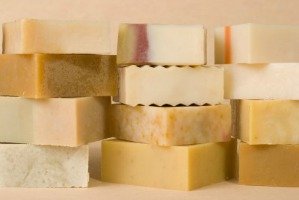hot process soap making
Hot process soap making resembles the cold process; the difference is that heat is added after trace to ensure saponification.
The soap mixture is heated:
- on the stove,
- in a crockpot
- or in the oven.
Many soap makers like the convenience of crockpot soap recipes;you do need to be careful about splashing.
The main benefit to this method is that the soap does not require as long as a cure time.

Any cold process soap making recipe can be used to make hot process soap.
The hot process method does mean that youWILL handle lye (sodium hydroxide) and safety precautions and equipment willneed to be used.
Note that because of the caustic effect of lye, the equipment(crockpot,large saucepan, etc) that you use should ONLY be used for your soap making.
Gather your soap making supplies andequipment.
What you will need
- Rubber gloves.
- Goggles
- Digital scale
- Thermometer
- Heat safe container with spout
- Glass mixing bowls
- Spray bottle (small) with rubbing alcohol
- Rubber spatula
- Measuring spoons
- Stick blender
- Large saucepan or crockpot
- Knife or soap cutter
- Molds (soap mold. silicone bakeware, candy or candle molds, wood molds or hard cardboard boxes (mil cartons work) lined with parchment/freezer paper)
- Plastic wrap
hot process soap making instructions
Remember you need to wear a pair of goggles and gloves when you handle lye. NEVER pour water into lye – ALWAYS pour lye into water.
It is best to have all you soap making equipment and ingredients ready.
Your workspace should be covered.
Mold(s) are prepared and set out.
Print out a copy of the your recipe for a quick reference.
- Measure and set aside your essential oils or fragrances and any additives you will be adding to your homeade lye soap recipe.
- Weigh out your oils and butters using a digital kitchen scale.
- Place all of your oils and butter in saucepan or crockpot and heat them on low-medium heat. Use your thermometer to monitor that the temperature does NOT go over 150F.
- Weigh out your lye (sodium hydroxide) and your distilled water. Place your lye – water solution in a roasting pan of in the sink. This way if it bubbles over (how I am happy that I actually listened to this safety tip).
- Dissolve the lye (sodium hydroxide) by pouring lye (sodium hydroxide) into water distilled water LYE INTO WATER. Make sure that you do this in a well ventilated room or even outside. Take your time to make sure that it is completely dissolved, you will see the mixture becomes clear.
- Remove the oils/butters from heat between 120F and 160F.
- Pour slowly your lye-water mixture into the heated oils and butters.
- Use a stick hand blender to mix the soap solution. You should be still wearing your goggles and gloves. Be careful not to splash. Continue to mix until you’re the mixture reaches trace (this means that the mixture has thickened enough that when you drizzle some on the top of the mixture, it leaves a trail (trace) on top).
- Cook the soap mixture onlow for about 2-3 hours in crockpot or stovetop You need to stay close by in case in bubbles over, if you see the mixture rising give it a stir and it will drop down.
- Test to see if it ready after the soap has thickened andhas a glossy texture. To see if it has cooked enough use phenolphthalein, ph strips or simply take alittle soap mixture with your gloved hand, test a very little bit on yourtongue, if it zaps then it is not ready, if it does not then you are good to go.
- Mix in your scents, colorand additives.
- Scoop soap into molds.
- Cover mold(s) with plasticwrap or a cover to protect the soap.
- Let the soap set for 24-48 hoursor so before taking it out of the mold(s). Unmold and cut the soap into bars.
- Your soaps are ready to use but many hot process soap makers prefer to let them cure for 1 or 2 weeks.
Any cold process or lye soap recipe can be used for this method.
Choose hot process soap recipes orcrockpot soap recipes here.
Leave Hot Process Soap Making and go to Homepage.
Recipes
About Soap Making
Soap Making Methods
- How to Choose Soap Making Recipes
- Melt and Pour Soap Making
- Cold Process Soap Making
- Room Temperature Soap Making
- Hot process soap making
- Rebatching Soap Making
- Liquid Soap Making
More Great Stuff!
Site Policies
By Ron & Andrea Rennick, Copyright © 2012 to 2015 www.ridgesoap.com
– All Rights Reserved
